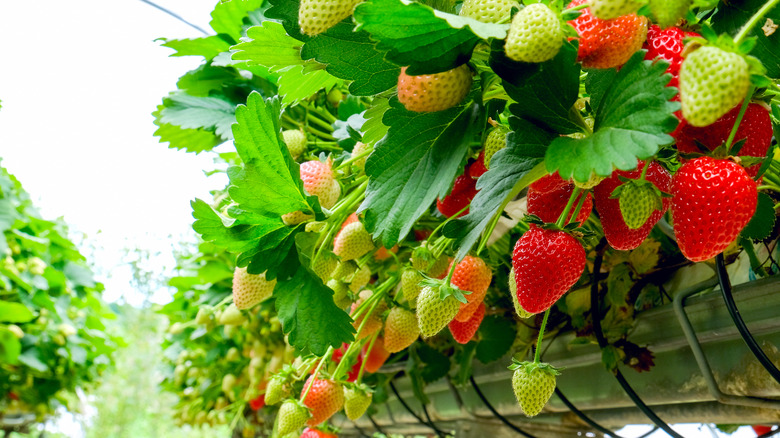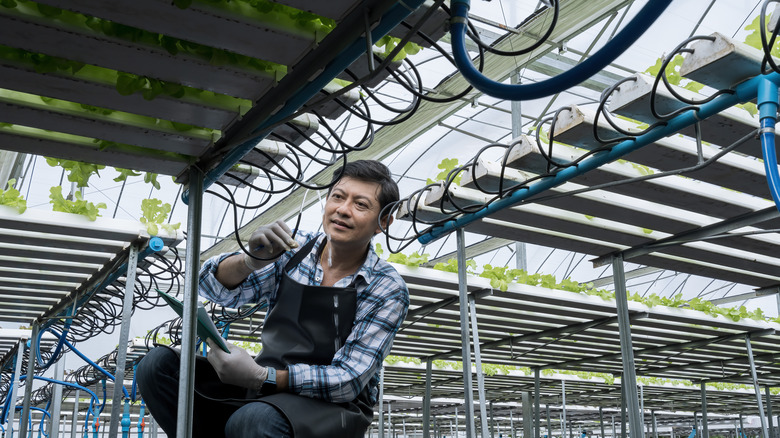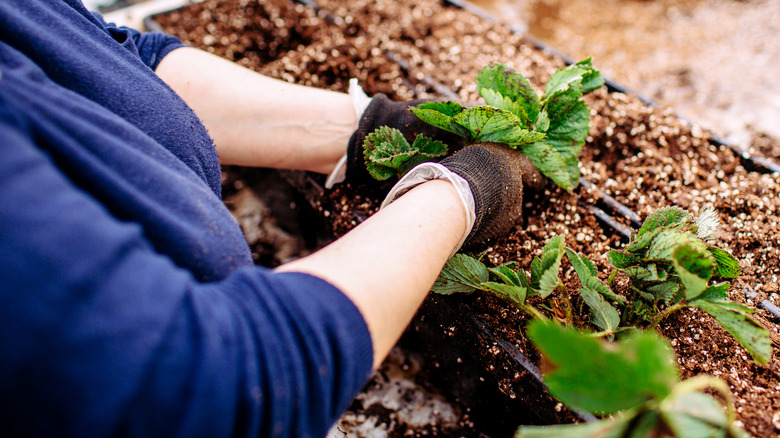What Are Hydroponic Strawberries, And How Do You Grow Them?
Chock full of vitamins, antioxidants, and minerals, strawberries are the succulent, sweet addition that takes jams, smoothies, and jellies from good to great. Unfortunately, for reasons best known to nature, these superfoods refuse to fruit year-round, making them quite expensive during the winter — but not anymore. Lately, home gardeners have adopted hydroponics to grow strawberry plants. So, what are hydroponic strawberries? Hydroponics is a portmanteau of hydro (water) and ponos (labor). Simply put, it's the practice of growing strawberries without soil in a watery, nutrient-heavy solution. However, some gardeners prefer suspending their plants in solid mediums like coconut coir, rockwool, perlite, clay, wood fiber, or vermiculite for better root anchorage.
Growing hydroponic strawberries has many advantages, too. Going soilless means you can raise the planting height (think vertical allotments), sparing your back when harvesting the juicy berries. It also takes care of soil-borne, disease-causing microbes like nematodes that affect fruiting. Conversely, going hydroponic raises yields by improving the roots' access and intake of oxygen. Additionally, complete control over the growth environment implies you can grow them anytime, anywhere, from the driest regions to the coldest areas. The icing on the top? Water and fertilizer requirements are reduced drastically. AmHydro, a hydroponics system seller, states hydroponic strawberries require only ⅒ of the water and ⅙ of the fertilizer of soil-grown strawberries.
Setting up a hydroponics system
While even brown thumbs will have luck growing hydroponic strawberries, it requires some planning. Begin by selecting a certified pest and disease-free strawberry variety. Day-neutral, which fruit and flower regardless of day length, and everbearing varieties that produce three harvests yearly are the best fit. They include Douglas, Tuft, Brighton, Albion, Monterey, and others. Also, decide if you'd rather start with plugs (small plants with roots) or runners that've been separated from the mother plant. Alternatively, you can sow seeds, but they'll take nearly two to three years to bear fruit.
Next, zero in on the right hydroponics system. Ebb and flow and nutrient film technique (N.F.T.) are favorites, although options like drip irrigation are available, too. Although the systems are similar, N.F.T. involves constantly pumping and recycling nutrient solution through a pot containing multiple clay pellet-laden strawberry cuttings. In contrast, ebb and flow follows a timer-based approach in which the young plants are flooded periodically. Although you can DIY your hydroponic system, buying ready-made systems makes things easier, especially if you're just starting. Base your decision on your budget, available facilities (pumps or drainage), and strawberry variety. For instance, lighter alpine varieties with shorter fruiting seasons go well with the N.F.T. system.
Growing hydroponic strawberries
Ideally, hydroponics systems come with a potting medium, but if they don't, choose a highly porous substrate, as strawberries' roots demand more oxygen. However, avoid using 100% coconut coir, as it restrains the plant's growth (via CEAC's experiment). Instead, combine it with perlite or rockwool. Strawberries flourish in soils with pH levels ranging between 5.5 and 6.0. Any higher and their foliage turns chlorotic. This is important since these hydroponic plants aren't watered much, just short of 500 milliliters daily for over 2 liters of substrate.
The nutrient solution (passed through the system) naturally turns the soil basic over time (due to the ionic exchange). However, root deterioration offsets this a bit. So, while giving the strawberry plants a heady mix of nitrogen, phosphorus, and potassium is essential, maintaining nitrogen's contribution at 10% is necessary to avoid aggressive shoot growth. Otherwise, you risk the soil becoming overly alkaline. Also, don't forget to include trace elements like calcium and magnesium, and use any variety-specific nutrient solutions available at the garden center. Maintain temperatures between 60 and 70 degrees Fahrenheit, and provide six hours of direct light or supplement with LED growth lights. Finally, shake or swab cotton over planted plugs to promote pollination. Harvest when it's time.


